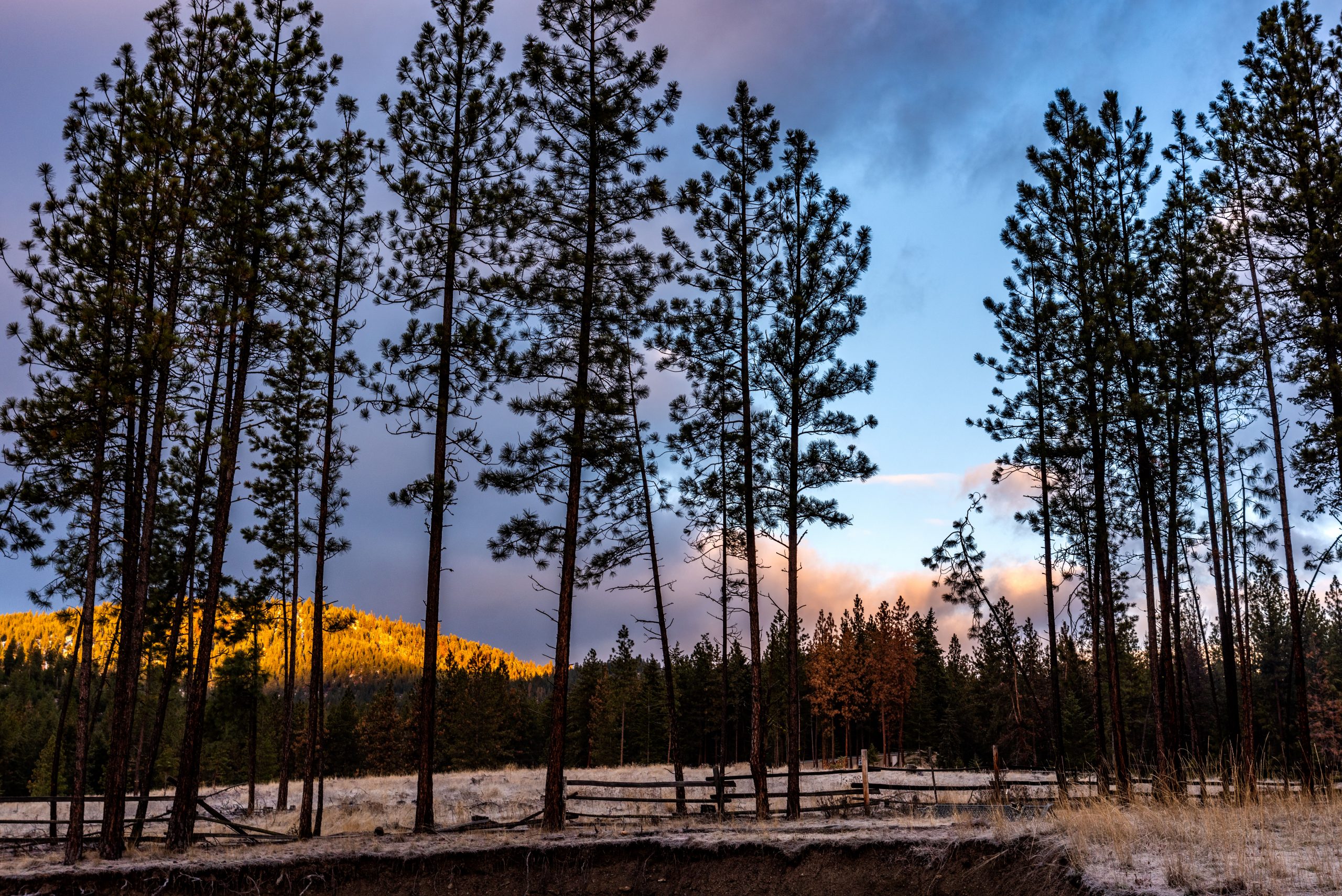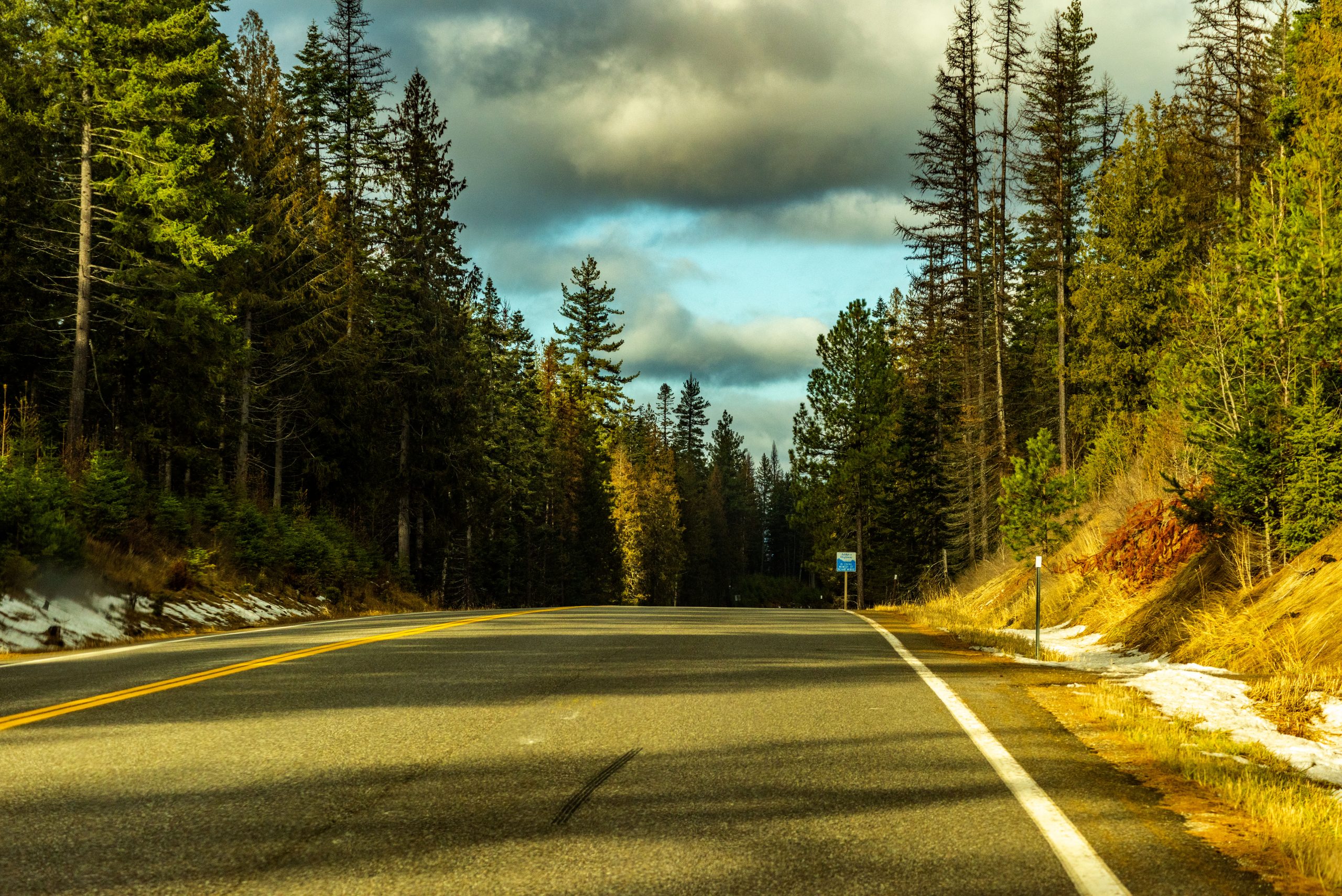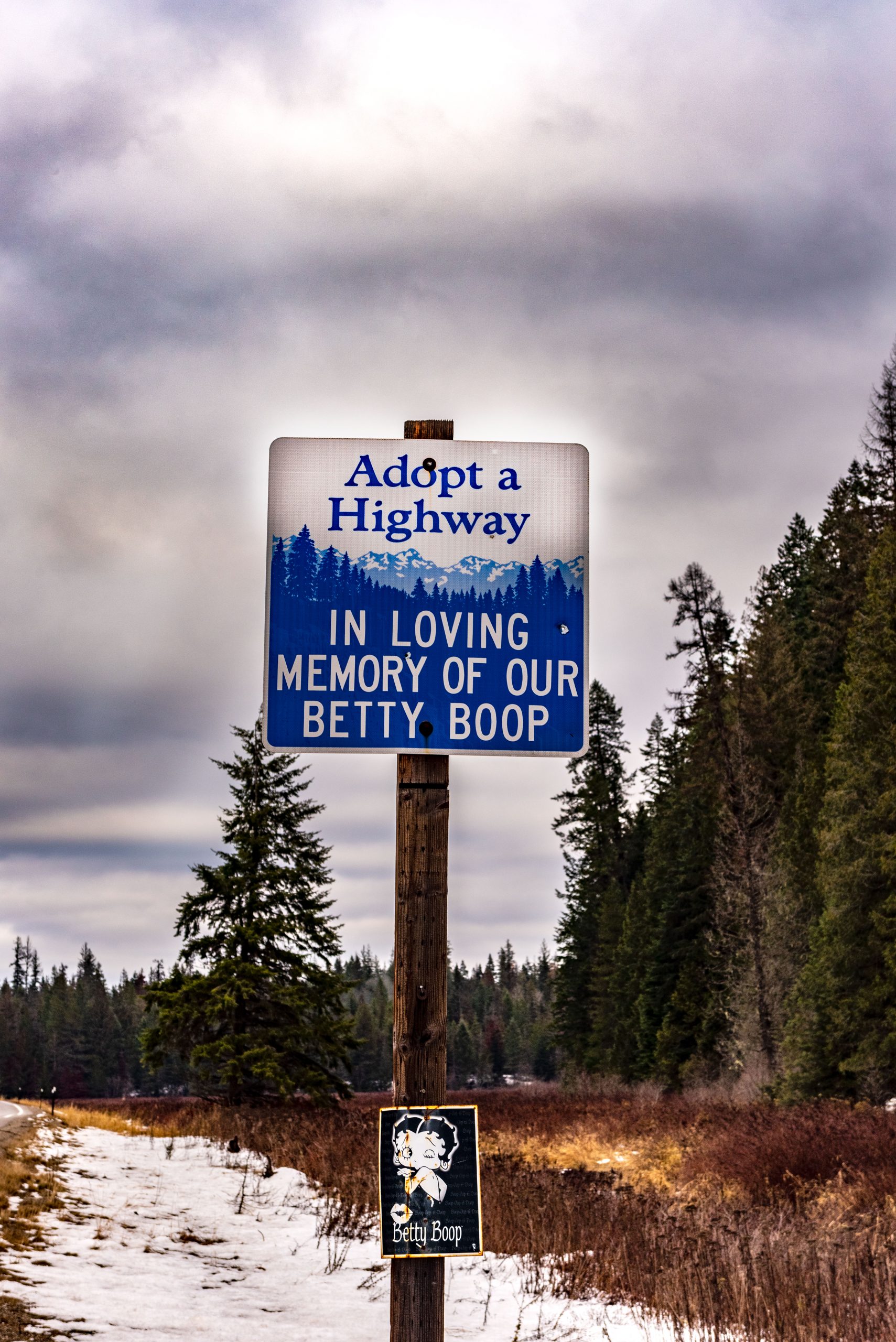A November Sunday Drive–on a Saturday

It should come as no surprise that Kevin and I like taking Road Trips. Friday night, in bed, Kevin asked where we should go on Saturday. My immediate response was Spokane, but then I suggested Glacier. In normal years, we make several trips to Glacier each year. In 2020, which we all know has not been a normal year, we have not made one. Saturday morning, as I sat in my armchair, I heard Kevin announce “If you’re going with me, you’d better get ready.” That was my signal to shower, dress and gather my stuff together. The weather forecast called for clouds in the morning, clearing by afternoon. As I stepped out onto the driveway, the scene to the west grabbed my attention. I grabbed my camera. Doesn’t this promise a spectacular day for a November Sunday drive?
A Note About Cameras and Lenses
We have barely gotten underway, and already I’m taking a side trip. In the twenty years I’ve owned digital cameras, the industry has made great strides forward. I won’t talk about the Panasonic Palm Cam I took to Turkey in 2000. Rather I will confine my remarks to the two main types of digital single lens reflex (DSLR) cameras I’ve owned since 2006. In December 2006 I bought a Nikon D80 DSLR as a Christmas present for myself. That camera served me well, but everything has a lifespan, and by 2014, I had taken so many photographs with that D80 that I had reason to fear its near death. For my birthday, Kevin bought me a Nikon D7100. Not surprisingly, the camera industry had moved the bar quite a distance between the D80 and the D7100. One thing they both had in common was the size of the sensor.
Both cameras had an APS-C sensor. Most people know that an APS-C sensor is smaller than a full-frame sensor. What they may not know is why APS? Well, it turns out that in 1996, Kodak introduced a new film size called Advanced Photo System (APS). If you’re old enough, you may remember small cameras that took 110 size film. APS was a replacement for 110—not that you could use APS film in a 110 camera. The APS-C digital sensor is roughly the same size as APS film. A full frame camera, on the other hand, is supposed to be the same size as 35 mm film. Now you know.
The Camera I Use Now
Christmas 2017 brought a new camera into my life. After conferring with our friend Mike Henry, Kevin bought me a Christmas present—a Nikon D810. The D810 is a full frame camera, and the first “professional-level” camera I have owned. I transferred the lens from my D7100 to the D810 and continued happily taking photographs. I LOVE my D810. It amazes me how much simpler this “professional-level” camera is.
One thing we noticed, however: the camera did not start numbering photographs with 0001. Rather it numbered the first photo I took 8282. We checked the shutter activations, and found that my “new” camera was not new. It had taken more photos than the D7100 it was supposed to replace. We complained to the vendor, and they rushed me a new camera and a new lens. On January 3rd, 2018, I began taking photos with the new “new” camera and my photo identification numbers went from 8646 to 0001. Yesterday I took photo number 7277 with that D810.
Lenses
Over the years (2006-2014) I purchased many lenses. Fortunately Nikon lenses fit Nikon cameras. Unfortunately, lenses designed for APS-C cameras do fit full frame cameras. I say “unfortunately” because while I can use my old lenses with my new camera, the camera compensates. By that I mean, Nikon designed the D810 to pretend it is an APS-C camera if you use an APS-C lens (or in Nikon’s terminology, a DX lens). The lens that came with the new “new” camera was a Nikon 24-120 mm lens, designated an FX or full-frame lens. The size of my images increased substantially, as did the space they took up on my memory card and in my computer. And I can’t really say the image quality improved. I was taking great photos way back with the D80.
By this digression I mean to say that yesterday, before we hit the road, I went through my camera bag. I wanted to see if I had any other lenses that would act as full-frame lenses. Indeed I did. Several years ago, I found Kevin’s camera bag with Nikon lenses he used with a film camera. One of these was a 70-300 mm telephoto zoom lens. There is no FX mark on this lens—it predates digital photography. But remember, old style single lens reflex cameras used 35 mm film—the same size as a modern full frame camera. I tested it out, and sure enough, my camera read the 70-300 lens as an FX lens. I determined to test it out on the trip.
Heading West
As we drove down the driveway, I said “Where I’d really like to go is Priest Lake.” I do not recall Kevin saying anything, but we soon found ourselves heading west on Montana Highway 200. The road was bare and dry, and while clouds filled the sky, there were occasional patches of blue. Priest Lake is in Bonner County, Idaho. It’s a long narrow lake surrounded by resorts. Not the kind of place you go in November, but… I’m in the process of putting together a coffee table book on Idaho’s forty-four counties, and I had no pictures of Priest Lake. It seemed an appropriate destination for a November Sunday Drive.
I had mounted the telephoto lens on my D810, and looked forward to trying it out. Alas, I missed a perfect photo op as the long lens was too slow for a good shot out of a speeding truck. The river was glass-smooth at Noxon and the bridge, reflected in the water, was sublime. A shot I didn’t get. Nor did I get the swans swimming at the mouth of Bull River.
We crossed into Idaho, and I noticed that my favorite car lot—the one in the rock quarry east of Clark Fork—had expanded to at least double its previous size. I’ll get those shots as we return, I said to myself. We stopped in Sandpoint for Walmart and McDonalds, then headed on west following US 2 toward Washington. At Priest River, we turned north on Idaho 57.
Driving North

Idaho 57 runs north/south from Priest River in the south to Nordman in the north. The road continues on beyond Nordman, but not as an Idaho state highway. Between Priest River and Nordman, the road climbs gradually for 37 miles. Priest River lies at 2,139 feet elevation and Nordman is at 2,638 feet. Highway 57 is the main way to get to the resorts that flank Priest Lake, but at no point is the lake visible from the highway. Instead, you drive through a pine and cedar forest with little to see alongside the road. I did catch a highway sign I wanted to capture, and made myself a note to watch for it on the way south.
At Nordman, we continued north, but the truck’s navigation system told us we were not on 57. My Idaho atlas indicated that should we continue on, we would soon cross into Washington, and end up at Metalline Falls in Pend Oreille County. Instead, we turned around and found another road leading east from Nordman to the lake at Reeder Bay. I had hoped to get to the northern end of the lake, but as drove beyond Reeder Bay, the road became snow covered—and even tree covered. We drove around two downed trees before we decided to say enough. There’s only so much I’m willing to do on a November Sunday Drive.
Priest Lake
Back at Reeder Bay, we drove down a boat ramp tucked between a mansion and a fence saying “keep out.” At the lake shore, I attempted some photographs of the lake, but caught mostly private docks. There are a lot of cabins at Reeder Bay—and no privacy whatsoever. Driving around past cabins that varied from the aforementioned mansion to derelict house trailers, we found an adorable marina. The Granite Creek Marina looks as if it has been there since Noah berthed the Ark. It also looks as if a strong wind or a heavy snow would demolish the entire complex. There was no one to help us—it is November, after all—but there was a metal box fastened to a pole. That was where you put your money to pay the fee for launching or berthing your boat. I took some more photos of the lake nearby.
Heading back toward Nordman, we stopped at a construction site where one man was working to build a series of large guest houses—condos—vacation rentals? Two duplexes already sat on the waterfront, but at least five more buildings were under construction, each three stories high. Each one looked as if it would contain at least six apartments, just judging by the windows. This is the second time I’ve been to Priest Lake, but both times were in November. It’s hard to imagine the crowds that must fill every available space in Summer.

Back to Priest River
One more stop at Ledgewood Picnic Area allowed me to get a few more photos, and gave the dogs a chance to empty their bladders. (Yes, of course all three dogs were with us. It’s a family trip, after all.) From Ledgewood we returned to Nordman, then headed south on 57. Beginning to head home on our November Sunday Drive.
Driving back south on Highway 57, we took one more side trip to Kalispell Bay and the Elkins Resort. Now this looks like a place to stay. Elkins Resort has been a fixture on Priest Lake since 1932 and has cabins that can accommodate 4 to 14 guests each. With a restaurant, bar, boat ramp and berths and store, there’s not much more you’d need to enjoy yourself.
Returning to Highway 57, east of Luby Bay, we hit the highway right at the turn off for the Priest Lake Library. Built as the Lamb Creek School, the building became the Priest Lake Library in 1974. In 1999, the National Register of Historic Places recognized the importance of the log building. Next to the main library, there is a Used Book Barn, in case you need to add to your vacation reading list.
Heading Home
Once back to Priest River, we drove through the town itself. Nine buildings in downtown constitute the Priest River National Historic District. I photographed two of the buildings, and look forward to catching more on my next trip to this charming small town on the banks of the Pend Oreille River.
The truck was acting up, and the day was getting long, so we headed home, stopping only to eat a late lunch/early supper in Clark Fork. I won’t review the restaurant we visited. That’s a story in itself. Crossing into Montana, the truck recognized it was home and gave us no more problems. All in all, it was a great day and a great November Sunday Drive, even if it was a Saturday.
Oh, and that Adopt-A-Highway sign? I caught it on the way south on 57. I think you’ll agree it was worth the stop.

![]()

0 Comments on “A November Sunday Drive–on a Saturday”